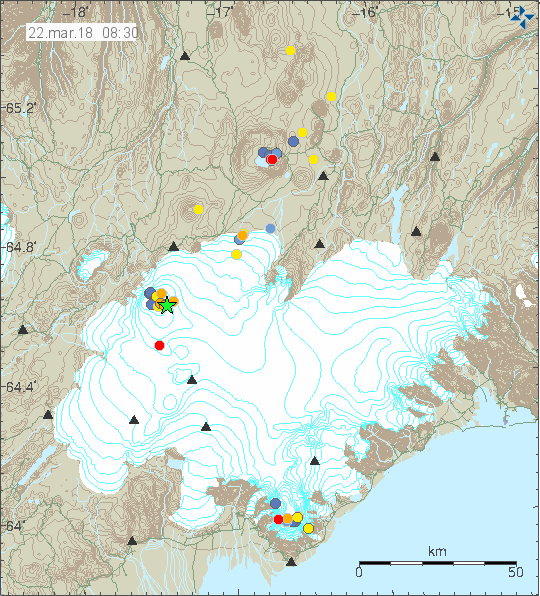A sharp earthquake the largest and most active volcano in the Central Highlands yesterday evening. A 4.3 magnitude earthquake was detected at 22:56, followed by two relatively powerful aftershocks, and half a dozen smaller quakes. These are the first quakes in the volcano since the end of January when the volcano was hit by the largest quake since the end of the 2014-15 Holuhraun eruption.
Read more: Bárðarbunga continues to tremble: Most powerful quake since end of 2015 eruption
Bárðarbunga remained relatively quiet during February when a massive earthquake episide which lasted days and included hundreds of quakes shook the island of Grímsey off the North Coast of Iceland.

Any quake in an active volcano which is larger than three on the Richter scale is considered a powerful quake. Quakes larger than 4 are relatively rare, and are associated with significant geological activity in the volcano.
Read more: Quick primer on Bárðarbunga, Iceland's most powerful volcano
According to the Seismic Monitoring System of the the Icelandic Meteorological Office the epicenter of the 4.3 magnitude quake was 5.9 km (3.7 mi) East-Northeast of the center of the volcano's caldera at a significant depth of 8 km (5 mi). The other two 2+ tremors had an epicenter in the in the same region, both at a depth of 5 km (3.1 mi).
Volcano is filling up its lava chambers
Bárðarbunga has been showing significant level of activity in recent months. The quakes are connected caused by magma being thrust from the earth's mantle up into the lava chambers of the volcano. The volcano has been re-filling it's lava chambers since the end of the 2014-15 Holuhraun eruption.
Read more: Why the constant earthquakes? Iceland is slowly being torn apart
Bárðarbunga, which is one of the most powerful volcanic systems in Iceland, is hidden beneath the north-western part of the ice cap of Vatnajökull glacier.
A sharp earthquake the largest and most active volcano in the Central Highlands yesterday evening. A 4.3 magnitude earthquake was detected at 22:56, followed by two relatively powerful aftershocks, and half a dozen smaller quakes. These are the first quakes in the volcano since the end of January when the volcano was hit by the largest quake since the end of the 2014-15 Holuhraun eruption.
Read more: Bárðarbunga continues to tremble: Most powerful quake since end of 2015 eruption
Bárðarbunga remained relatively quiet during February when a massive earthquake episide which lasted days and included hundreds of quakes shook the island of Grímsey off the North Coast of Iceland.

Any quake in an active volcano which is larger than three on the Richter scale is considered a powerful quake. Quakes larger than 4 are relatively rare, and are associated with significant geological activity in the volcano.
Read more: Quick primer on Bárðarbunga, Iceland's most powerful volcano
According to the Seismic Monitoring System of the the Icelandic Meteorological Office the epicenter of the 4.3 magnitude quake was 5.9 km (3.7 mi) East-Northeast of the center of the volcano's caldera at a significant depth of 8 km (5 mi). The other two 2+ tremors had an epicenter in the in the same region, both at a depth of 5 km (3.1 mi).
Volcano is filling up its lava chambers
Bárðarbunga has been showing significant level of activity in recent months. The quakes are connected caused by magma being thrust from the earth's mantle up into the lava chambers of the volcano. The volcano has been re-filling it's lava chambers since the end of the 2014-15 Holuhraun eruption.
Read more: Why the constant earthquakes? Iceland is slowly being torn apart
Bárðarbunga, which is one of the most powerful volcanic systems in Iceland, is hidden beneath the north-western part of the ice cap of Vatnajökull glacier.







